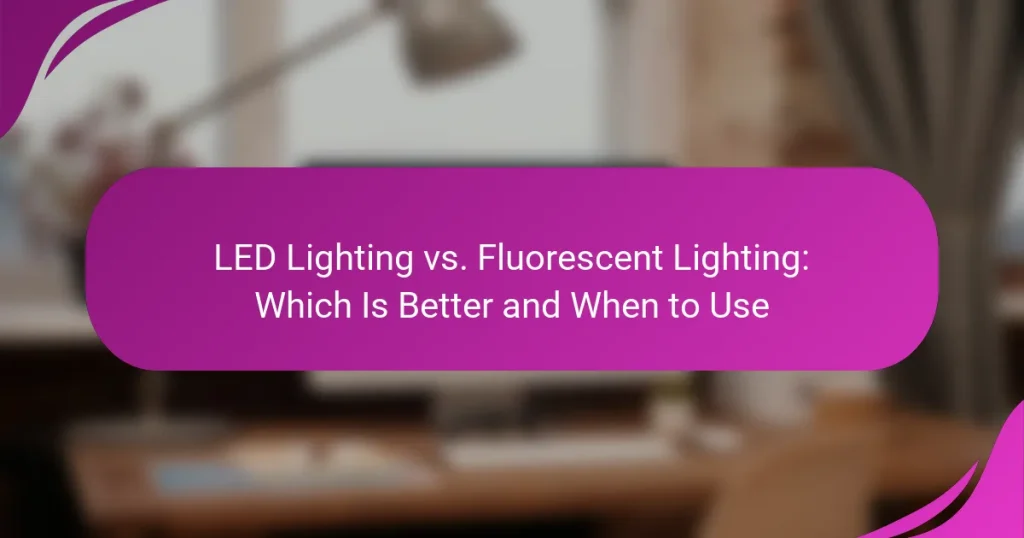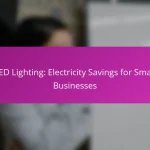When choosing between LED and fluorescent lighting, it’s essential to consider factors such as energy efficiency, cost, and application. LED lighting offers significant energy savings and longevity, making it ideal for commercial spaces focused on reducing operational costs. In contrast, fluorescent lighting may be more suitable for short-term use or budget-conscious projects, providing adequate illumination at a lower initial investment.
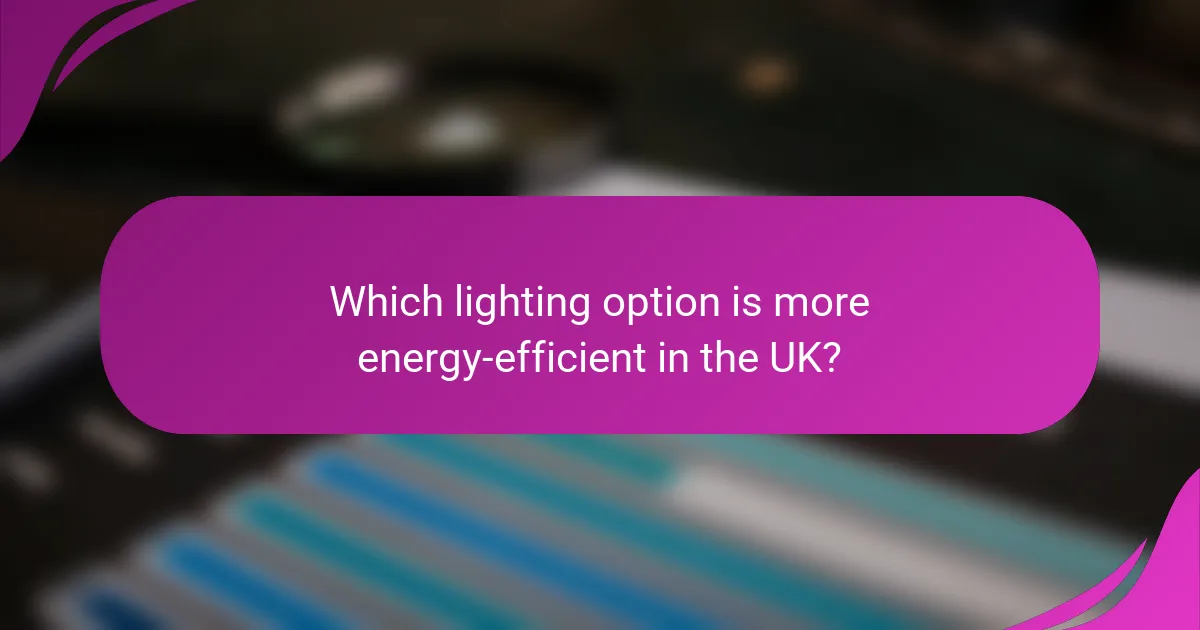
Which lighting option is more energy-efficient in the UK?
In the UK, LED lighting is significantly more energy-efficient compared to fluorescent lighting. LEDs can consume up to 75% less energy, making them a cost-effective choice for both residential and commercial use.
LED lighting consumes up to 75% less energy
LED lights are designed to convert a higher percentage of energy into light rather than heat, which enhances their efficiency. Typically, an LED bulb uses around 10-15 watts to produce the same amount of light as a 60-watt incandescent bulb or a 13-15 watt fluorescent bulb.
This efficiency translates into lower electricity bills and a reduced carbon footprint. For example, switching to LED lighting can save households and businesses hundreds of pounds annually on energy costs.
Fluorescent lighting is less efficient than LED
Fluorescent lights, while more efficient than traditional incandescent bulbs, still fall short when compared to LEDs. They generally use more energy to produce the same brightness and have a shorter lifespan, averaging around 7,000 to 15,000 hours, compared to 15,000 to 50,000 hours for LEDs.
Moreover, fluorescent bulbs contain small amounts of mercury, which poses disposal challenges and environmental concerns. This makes LEDs not only a more efficient choice but also a safer and more sustainable option for lighting needs in the UK.
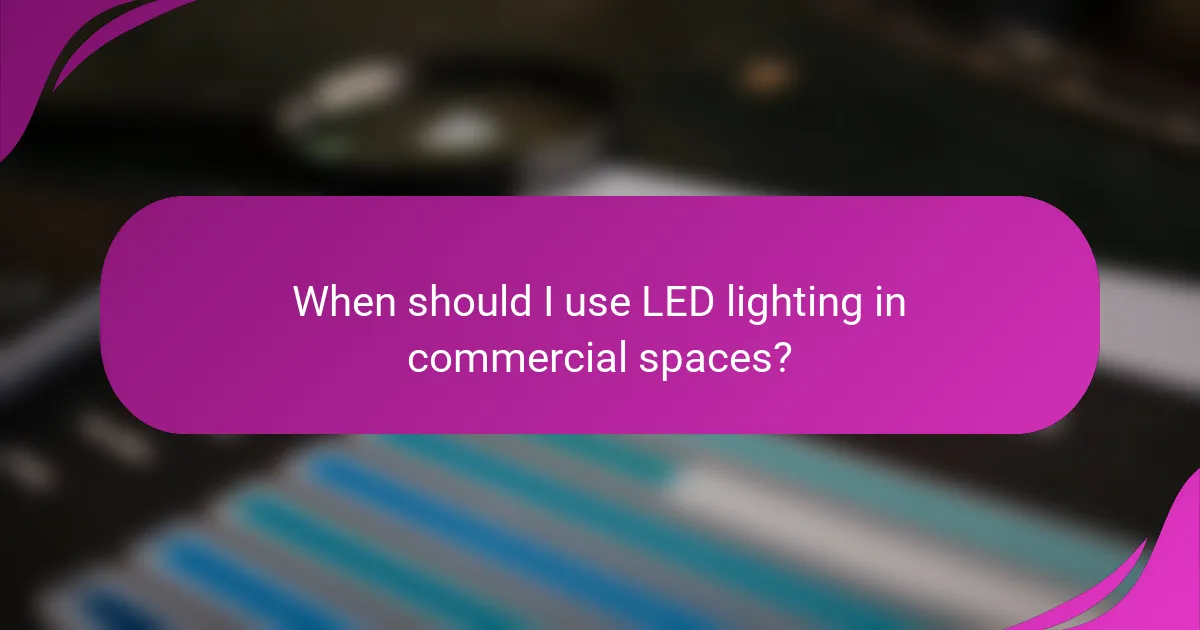
When should I use LED lighting in commercial spaces?
LED lighting is ideal for commercial spaces when energy efficiency, longevity, and low maintenance are priorities. Businesses should consider using LED fixtures in environments where lighting quality and cost savings are essential.
Ideal for retail environments
In retail settings, LED lighting enhances product visibility and creates an inviting atmosphere. The ability to adjust color temperatures allows retailers to highlight merchandise effectively, influencing customer behavior and increasing sales.
Additionally, LEDs produce less heat compared to fluorescent lights, which can help maintain a comfortable shopping environment. Their long lifespan reduces the frequency of replacements, minimizing disruption to store operations.
Best for offices with long operating hours
For offices that operate long hours, LED lighting is a smart choice due to its energy efficiency and reduced operating costs. LEDs consume significantly less power than fluorescent lights, leading to lower electricity bills over time.
Moreover, the longevity of LED bulbs means fewer replacements, which is particularly beneficial for offices that require consistent lighting. Choosing LEDs can also improve employee productivity and comfort, as they provide better color rendering and reduce eye strain.
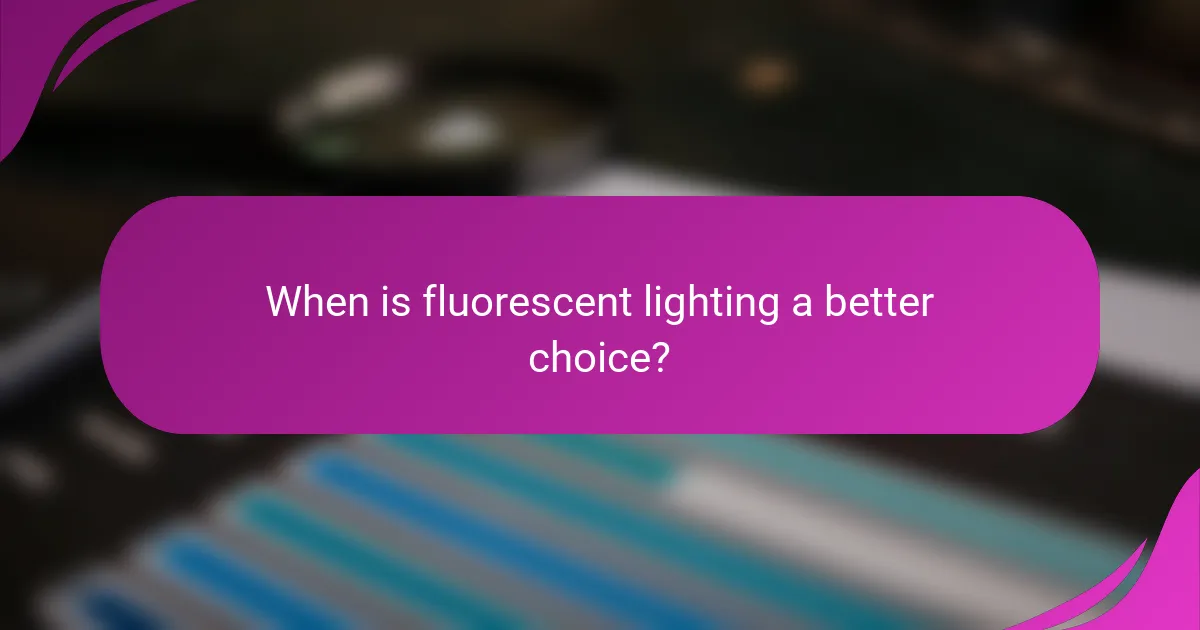
When is fluorescent lighting a better choice?
Fluorescent lighting is often a better choice for applications requiring short-term use or where initial costs are a primary concern. It provides adequate illumination and is generally more affordable to install than LED options.
Suitable for short-term lighting needs
Fluorescent lighting is ideal for spaces that require temporary illumination, such as construction sites or seasonal displays. Its quick installation and ability to cover large areas make it a practical solution for short-term projects.
Consider using fluorescent lights in areas where lighting needs may change frequently, as they can be easily replaced or adjusted without significant investment.
Cost-effective for initial installations
Fluorescent lights typically have lower upfront costs compared to LED fixtures, making them a cost-effective choice for initial installations. For example, a standard fluorescent tube can be significantly cheaper than an equivalent LED model.
When budgeting for a project, consider the long-term energy savings of LEDs versus the immediate savings of fluorescent lighting. In many cases, the lower initial cost of fluorescent options can be beneficial for tight budgets.
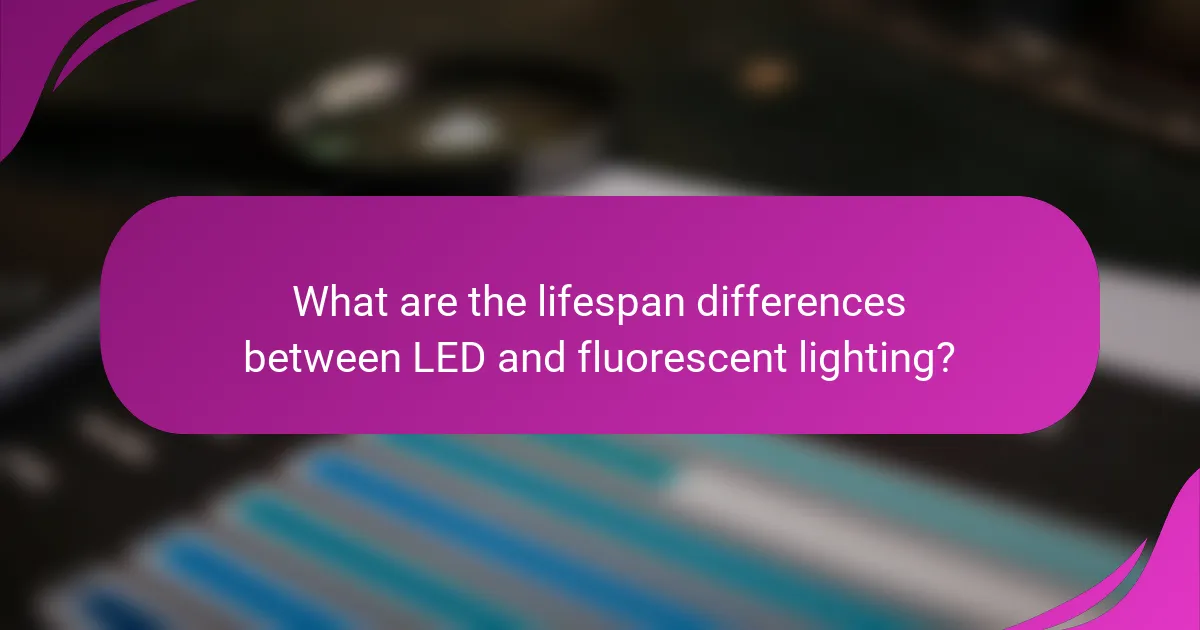
What are the lifespan differences between LED and fluorescent lighting?
LED lighting typically lasts significantly longer than fluorescent lighting, making it a more durable option for many applications. While LEDs can last up to 25,000 hours, fluorescent lights generally have a lifespan of around 7,000 hours.
LEDs last up to 25,000 hours
LEDs are designed to have a long operational life, often reaching up to 25,000 hours or more. This extended lifespan means fewer replacements, reducing maintenance costs and waste over time. In residential and commercial settings, this longevity can lead to significant savings in both time and money.
When considering LED options, look for products with a warranty of at least five years, as this often indicates a quality build. Additionally, ensure that the LEDs are compatible with your existing fixtures to maximize their lifespan.
Fluorescents last around 7,000 hours
Fluorescent lights typically last around 7,000 hours, which is considerably shorter than LEDs. This shorter lifespan can lead to more frequent replacements, increasing overall costs and effort in maintaining lighting systems. In environments where lights are used continuously, this can be particularly inconvenient.
While fluorescent lights may be cheaper upfront, the need for more frequent replacements can offset initial savings. Consider the total cost of ownership, including replacement bulbs and labor, when choosing between fluorescent and LED lighting solutions.

How do LED and fluorescent lighting compare in terms of light quality?
LED and fluorescent lighting differ significantly in light quality, with LEDs generally providing superior illumination. LEDs offer better color rendering and consistent brightness, while fluorescent lights can sometimes flicker and produce a harsher light quality.
LEDs offer better color rendering
LEDs are known for their excellent color rendering index (CRI), often exceeding 80, which means they can accurately reproduce colors in a space. This makes them ideal for settings where color accuracy is crucial, such as art studios or retail environments.
In practical terms, using LEDs can enhance the appearance of products and artwork, creating a more appealing visual experience. When selecting LEDs, look for those with a high CRI rating for optimal color representation.
Fluorescents may flicker and produce harsh light
Fluorescent lights can sometimes flicker, especially when they are nearing the end of their lifespan or if they are not compatible with the fixtures. This flickering can cause discomfort and eye strain for occupants in the space.
Additionally, fluorescent lighting can emit a harsher, cooler light, which may not be suitable for all environments. For areas like offices or homes, consider using warmer fluorescent bulbs or transitioning to LED options to create a more inviting atmosphere.
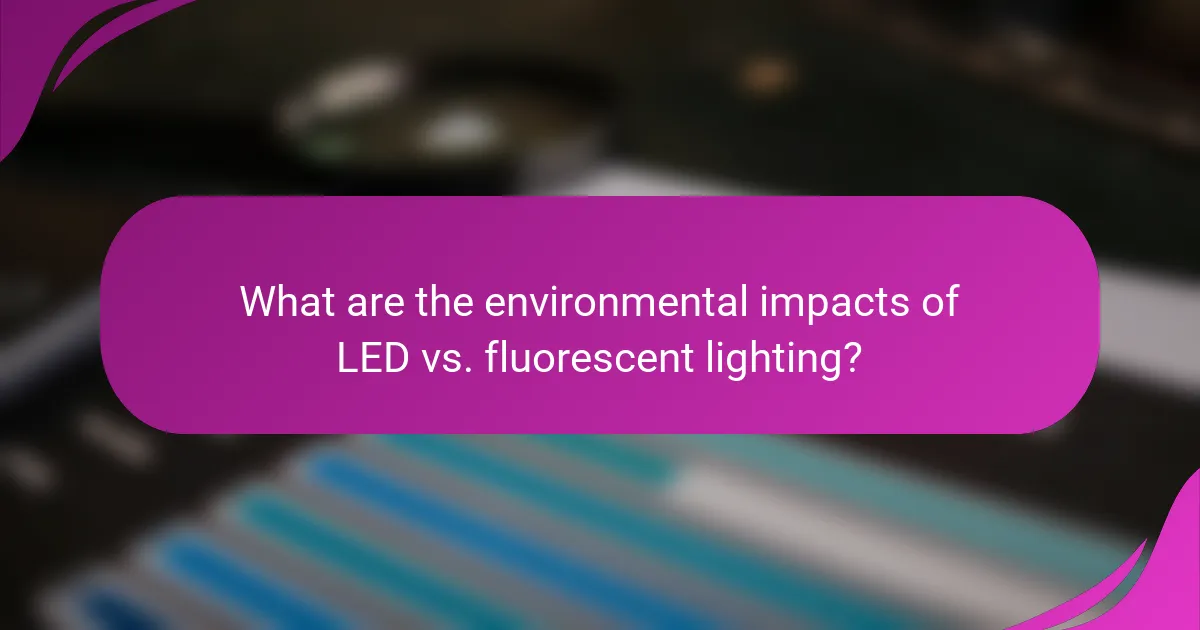
What are the environmental impacts of LED vs. fluorescent lighting?
LED lighting generally has a lower environmental impact compared to fluorescent lighting. While both options are more efficient than traditional incandescent bulbs, LEDs offer significant advantages in terms of energy consumption and waste management.
LEDs have a lower carbon footprint
LEDs are known for their energy efficiency, consuming up to 80% less electricity than incandescent bulbs. This reduced energy usage translates to lower carbon emissions, making LEDs a more sustainable choice for lighting.
In practical terms, switching to LED lighting can significantly decrease your electricity bills and reduce the demand on power plants, which often rely on fossil fuels. Over time, this can contribute to a substantial reduction in greenhouse gas emissions.
Fluorescents contain hazardous materials
Fluorescent lights contain small amounts of mercury, a hazardous substance that poses environmental risks if not disposed of properly. When these bulbs break or are discarded, they can release mercury into the environment, leading to soil and water contamination.
Due to these risks, many regions have regulations governing the disposal of fluorescent lighting. It is essential to follow local guidelines for recycling or disposing of these bulbs to minimize their environmental impact.
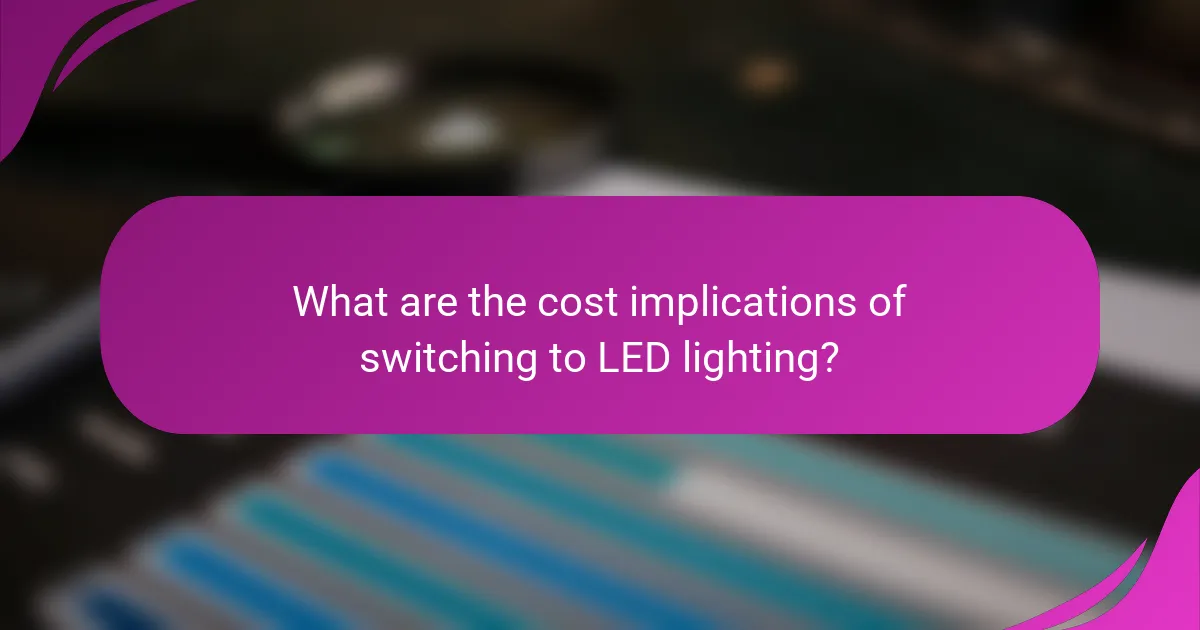
What are the cost implications of switching to LED lighting?
Switching to LED lighting involves higher initial expenses but offers significant long-term savings. Understanding these cost implications can help you make an informed decision about your lighting needs.
Higher upfront costs for LEDs
LED lights typically have a higher purchase price compared to fluorescent options. While a standard LED bulb may cost several times more than a fluorescent bulb, this initial investment is often offset by their longevity and efficiency.
For example, a single LED bulb might range from $5 to $15, while fluorescent bulbs usually cost between $1 and $5. However, the lifespan of an LED bulb can exceed 25,000 hours, compared to about 7,000 to 15,000 hours for fluorescent bulbs.
Long-term savings on energy bills
Despite the higher upfront costs, LEDs can lead to substantial savings on energy bills. They consume significantly less electricity, often using about 75% less energy than traditional fluorescent bulbs.
For instance, if a household replaces 10 fluorescent bulbs with LEDs, the monthly savings on electricity could range from $5 to $15, depending on local energy rates. Over time, these savings can accumulate, making LEDs a more economical choice in the long run.
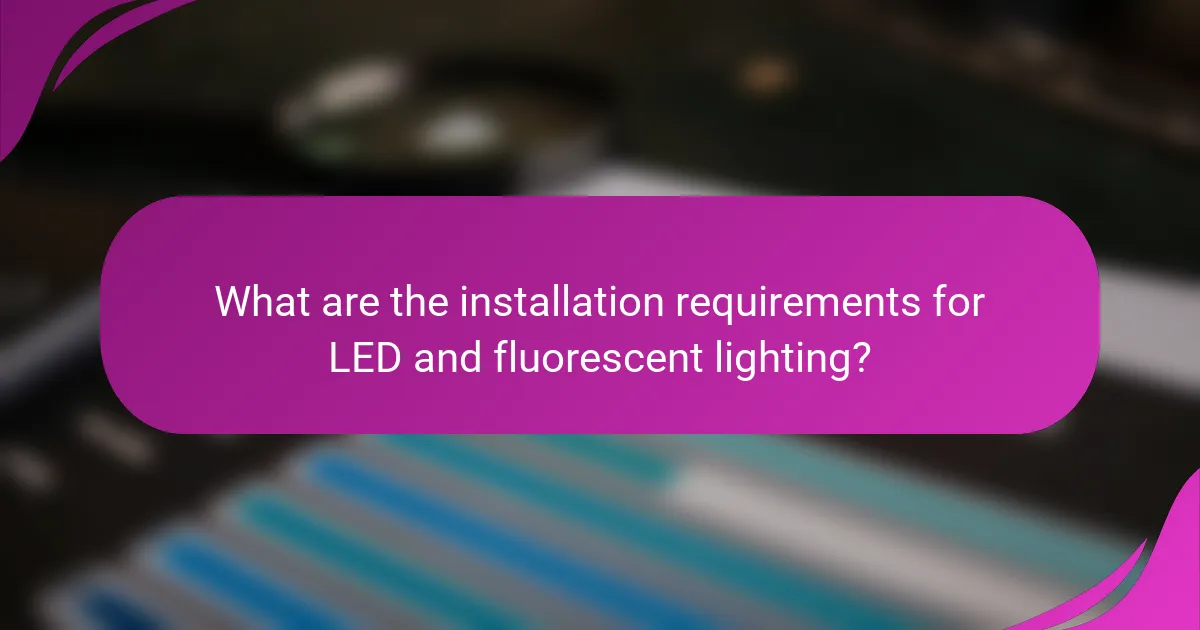
What are the installation requirements for LED and fluorescent lighting?
LED and fluorescent lighting have distinct installation requirements that can influence your choice. LEDs typically require less complex setups and can often be retrofitted into existing fixtures, while fluorescent lights may need specific ballasts and more careful placement.
LEDs can be retrofitted easily
One of the main advantages of LED lighting is its ability to be retrofitted into existing fixtures without significant modifications. This means that if you have traditional incandescent or fluorescent fixtures, you can often replace the bulbs with LED options that fit the same socket.
When retrofitting, ensure that the LED bulbs are compatible with the existing fixture’s voltage and wattage. Many LED products are designed to work with standard fixtures, making the transition straightforward and cost-effective.
Additionally, retrofitting can lead to energy savings of up to 80% compared to traditional lighting, which can significantly reduce electricity bills over time. Always check for local rebates or incentives that may be available for upgrading to LED technology.
